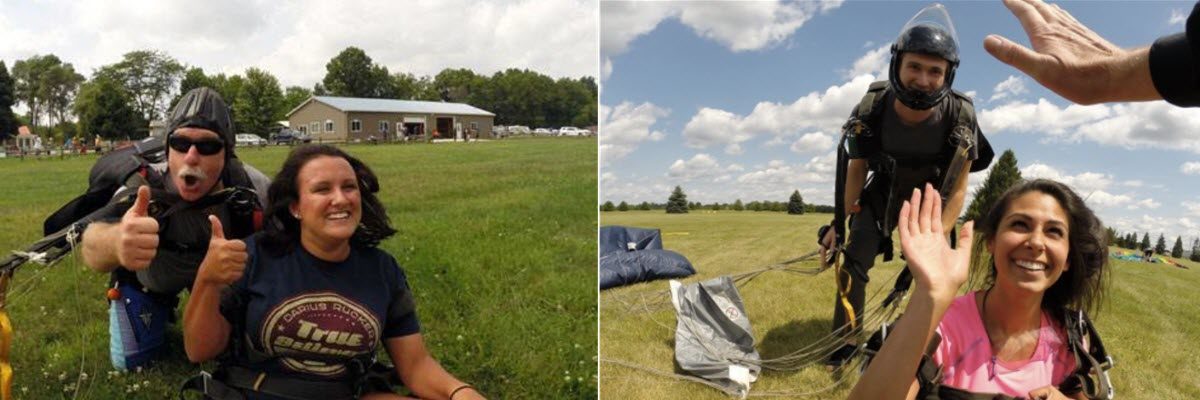- Michigan's Premier Skydiving Center
- Call Now: (517) 423-7720

The Tandem Skydive Landing
Thursday, August 31, 2017
- Skydive Tecumseh
- 8/31/17
- 0
- General
Tandem skydiving is a skydive made with two people – exactly as it sounds! It’s the most common way people get into skydiving, and is enjoyed by thousands of people across the States every year. You’ll be connected to a highly qualified skydiving instructor for the duration of your skydive. Attached to their front, you’ll be able to experience everything about skydiving, without having to complete a skydiving course or learn how to manage the equipment.
With that said, you’re not there as a passenger. Far from it! Instead, you’re what we call a ‘tandem student’, which means you play a role in the jump. This means you’ll be asked to adopt an exit position and a freefall position with your body, and you’ll be asked to lift your legs for landing. Here is everything you need to know about how to land while tandem skydiving.
How to Land Skydiving
If you’ve ever watched skydivers coming into land, you’ll have seen lots of different landing techniques and styles. On the whole, the plan is to land on our feet whenever possible. Advanced parachute pilots might perform maneuvers like ‘swooping’ which causes the parachute to build up speed across the ground. But the ‘norm’ is for the parachutist to fly straight in and stand up. The same doesn’t apply to tandem skydivers.
As a tandem skydiver, you can expect to land on your backside with your tandem instructor and slide in along the ground until you come to a stop.
Trust Your Instructor During Landing
One of the crucial parts of a tandem skydiving landing is to lift your legs up nice and high to keep them out of the way as you touch down.
This means that your tandem instructor can take control of the landing, either standing up themselves if they feel it’s appropriate to do so (and then letting you lower your legs into a stand too) or sliding in on their backside until you come to a stop. With your legs lifted out of the way, your instructor can make that decision and complete the jump safely in the knowledge that your legs aren’t going to get in the way and that you’re not going to try to stand up if it’s not time to do so.
Reduce the Risk of Landing Injuries
The main reason we ask you to lift your legs for landing is to reduce the risk of injury as much as possible. If you were to try to put your legs down, you might stand sooner than you should, and this could lead to you falling over – and your tandem instructor falling over you! The worst-case scenario is that you put down your legs too soon and end up taking the force of the landing through your bones, which can, in extreme cases, cause broken bones.
By bringing your legs up, you keep them out of the way and keep them safer.
Lift Your Legs For Landing
Lifting your legs for your tandem landing shouldn’t be too difficult. You should be able to prove you can do it before you make your jump – that’s how important it is! Try it now! Sit down on your couch and try lifting up your legs straight in front of you. If you struggle at all, try putting your hands under your knees and using them to assist. Of course, you’ll receive a full brief from your tandem instructor in advance of your jump, so you’ll learn exactly what to do before you even get on the airplane.
Are you ready to skydive? Find out more about tandem skydiving today!

Wonderful staff -- my tandem instructor, James, was funny, clear, and made sure that I was comfortable during the entire experience (which involved two flights and a bit of "will-we-or-won't-we" due to clouds).
The dive itself is unreal -- exhilarating and meditative, terrifying and relaxing, absolutely breathtaking. I absolutely recommend you try it here first. Skydive Tecumseh has a great reputation, and there's a reason for that. I hope to go again.
John Maguire
Copyright © 2024, Skydive Tecumseh, All Rights Reserved.
DropZone Web Design & Marketing by Beyond Marketing, LLC